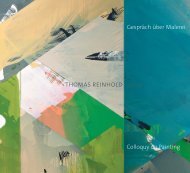Create successful ePaper yourself
Turn your PDF publications into a flip-book with our unique Google optimized e-Paper software.
Ingo Nussbaumer<br />
THOMAS REINHOLD:<br />
<strong>MATRIX</strong> PICTURE – REPRESENTATIONALLY<br />
FORMULATED ABSTRACT PAINTING<br />
There seems to be some basic experience of a picture, or, more precisely, of a painted picture,<br />
i.e. a painting. As artists, we are obliged not only to create differences between pictures, but<br />
also to speak about the differences between pictures. A picture is not simply a picture, because<br />
we also lay claim to art.<br />
This (as yet) unidentified basic experience of a picture leads us away from the concept of<br />
depiction usually employed and towards that of a process in which the picture is executed<br />
as an object for the viewing subject, as an independent agent, and is elucidated as a process<br />
of execution. Let us describe the basic experience more clearly: it is the picture as an object<br />
which attracts us, and which, in the act of seeing, confronts us at every stage of its execution,<br />
through action, active looking and constantly repeated viewing. 1 Processuality, rather than description<br />
is what is expressed by the picture, which is no longer to be interpreted as a window,<br />
i.e. as a section in a visual pyramidal space, as the older theories of aesthetics encouraged us<br />
to do.<br />
Where does it originate, this apparently so absurd experience, which is, moreover, termed ‘constituent’?<br />
An object without an eye, without any organ of sense, without any apparent intellect,<br />
looks at us, confronts us and responds to our gaze! When we look at things, are they able to<br />
tell us something with intellect and feeling, expressing something deeper? Would we not then<br />
understand the word ‘tell’ differently? As a kind of purely ingenious, wily transmission? What is<br />
this transmission? Do not the eyes of the others tell us something instantaneously, in the same<br />
way that words – when we are reading sentences – tell us something about things and topics,<br />
although not about abstracted things and words? Do we not already read sadness, joy, curiosity,<br />
enthusiasm or concern into looks? How can objects be capable of expression, and even precisely<br />
this expression which refers to one particular point, as if they were themselves trenchant<br />
language? It is, for instance, as if this honey were to become the essence of the notion of sweetness,<br />
this chair the essence of the notion of sitting, this picture the essence of beholding? Then<br />
the content and the experience would have to be taken into consideration, something rich in<br />
experience and in expression would have to already exist, in order to be the experience of the<br />
thing itself in the experience.<br />
5<br />
Let us allow a picture to speak as an example of this, namely Thomas Reinhold’s Bild (‘Picture’),<br />
2016, oil on canvas, 210 x 230 cm (page 1 and previous double page).<br />
Colours are arranged on a flat surface. The tones are predominantly darker ones, superimposed<br />
one upon the another, overlapping and forming thread-like trickles, running upwards,<br />
downwards and sideways, as if – this, by way of comparison – stretched out in the form of a grid,<br />
a matrix of linear values, passing through which we are invited to enter into a further space;<br />
into a space composed of colour and structure, so that a broader and deeper background both



